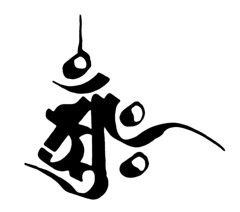 I've lost count of the number of times I've been asked about one particular bīja or akṣara. In Roman it is: āṃḥ. It seems that one particular version of this has captured the imagination of people browsing the web (see left). I'm not clear where the original came from, but it may be attributable to tattoo artist Andy Shou.
I've lost count of the number of times I've been asked about one particular bīja or akṣara. In Roman it is: āṃḥ. It seems that one particular version of this has captured the imagination of people browsing the web (see left). I'm not clear where the original came from, but it may be attributable to tattoo artist Andy Shou.In my opinion this letter is not particularly well done, the lines are somewhat skewed - it is probably a design rather than calligraphy and therefore lacks the proper proportions and the connectedness that comes from a practised hand.
I have some basic info on this figure on my letter 'a' page.
The story is that in the
 Mahāvairocana Abhisaṃbodhi Tantra, one of two centrally important Tantric Texts for the Japanese Shingon School of Buddhism, the four basic variations on the letter a (ie a ā aṃ aḥ) are linked to the four stages of practice: bodhi, carya, saṃbodhi, nirvaṇa. The combined elements of all four letters give the figure in question and represent the culmination of Buddhist practice. It also stands for Mahāvairocana, the Dharmakāya Buddha as he appears in the Garbhadhātu Maṇḍala.
Mahāvairocana Abhisaṃbodhi Tantra, one of two centrally important Tantric Texts for the Japanese Shingon School of Buddhism, the four basic variations on the letter a (ie a ā aṃ aḥ) are linked to the four stages of practice: bodhi, carya, saṃbodhi, nirvaṇa. The combined elements of all four letters give the figure in question and represent the culmination of Buddhist practice. It also stands for Mahāvairocana, the Dharmakāya Buddha as he appears in the Garbhadhātu Maṇḍala.I've done a fresh calligraphy in my current style for this blog entry.


 I came across this report on
I came across this report on 